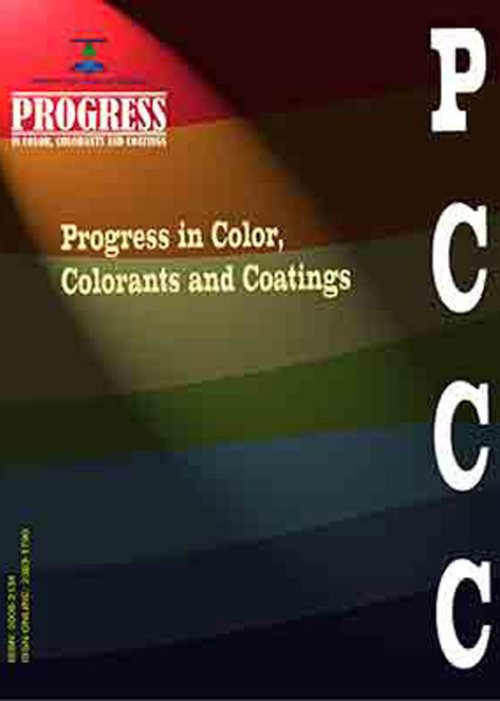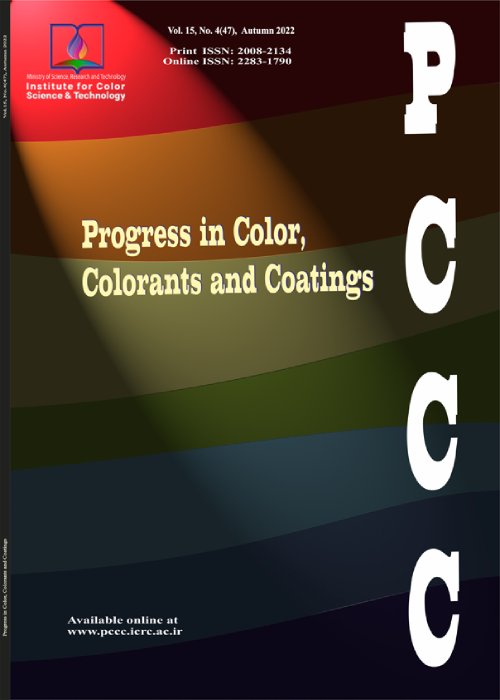فهرست مطالب

Progress in Color, Colorants and Coatings
Volume:16 Issue: 1, Winter 2023
- تاریخ انتشار: 1401/08/30
- تعداد عناوین: 8
-
-
Pages 1-20
The adsorption characteristics of Basic Red 46 (BR46) were evaluated onto calcium oxide nanoparticles synthesized in two different procedure by combustion method. The operational parameters was checked out to achieve the optimum condition. The X-ray diffraction spectrum, FTIR and scanning electron micrograph of samples was obtained. Adsorption isotherms were determined by BET, Redlich–Peterson, Langmuir, Tempkin, Freundlich, and Dubinin–Radushkevich isotherms, and the results represented Langmuir and Tempkin isotherms as the best fitted one for the adsorption of dye on C1 and C2 (CaO samples), respectively. The adsorption kinetics was studied, and the rate parameters were evaluated at various dye concentrations (10-40 mg L-1) and pH values (3-9). The results conform to the pseudo-second-order kinetics for both samples. Thermodynamic analysis indicates the physical adsorption and endothermic reaction for the adsorption process. Moreover, to model the adsorption process, a computational fluid dynamic model has been performed applying the Matlab CFD code to predict the elimination of BR46 from the aqueous solution by C1 and C2 samples.
Keywords: Dye removal, Calcium oxide nanoparticles, Numerical modeling, Isotherm l Kinetics -
Pages 21-29
In this study, two inorganic additives with perovskite structure have been used as additives in fabrication of perovskite solar cells (PSCs). Ba2In2O5·(H2O)x and Ba2(In1.8Cr0.2)O5·(H2O)y was applied in perovskite precursor solution for synthesis of photo absorption layer in PCSs by a one-step solution method with solvent engineering technique. Cr-substituted and pristine Ba2In2O5·(H2O)x were prepared by solid-state and soft chemistry methods like the procedures in previous work, and utilized to improve the crystal structure and morphology of perovskite layer of PSCs. The morphology of the new perovskite layers was studied by FE-SEM, and XRD analysis. The results showed using 2 wt % of additives in precursor solution of fabricated PCSs increased the open-circuit voltage (Voc) of cells, also the power-conversion efficiency of the cells improved from 7.8 % to 9.7, and 9.3 % by using both additives respectively. Cr-substituted and pristine Ba2In2O5·(H2O)x could modify the coverage of perovskite film on the TiO2 layer and consequently improve the photovoltaic stability and performance of perovskite solar cells.
Keywords: Perovskite solar cells, Additive, Ba2In2O5•(H2O)x, Ba2(In1.8Cr0.2) O5•(H2O)y, Solvent engineering technique -
Pages 31-45
Cationic acrylic resins with different glass transition temperatures (Tg) and molecular weight (Mw) were synthesized using different ratios of methyl methacrylate (MMA) and tertiary butyl acrylate (TBA) monomers. Furthermore, waterborne acrylic coatings were prepared using the cathodic electrocoating application technique. The cathodic electrocoating process was carried out at 80 V for 120 seconds to obtain a dry film thickness of 20±2 μm. Fourier transform infrared spectroscopy (FTIR), GPC (molecular weight), glass transition temperature, particle size, zeta potential, and viscosity measurements were used to characterize the synthesized cationic acrylic resin. The throwing power (ability to coat recessed area) and cross-cut adhesion were evaluated for each resin. According to the electrochemical impedance spectroscopy (EIS) data and general properties, the coatings with an MMA/TBA ratio of 0.125 exhibited excellent corrosion resistance (Log |Z|0.01Hz stay above seven even after 720 hours dipping in 3.5 wt.% NaCl solution). By increasing the MMA/TBA ratio, the final product's average molecular weight and viscosity were increased.
Keywords: Acrylic resin, Cathodic electrocoating, Corrosion, EIS, Throwing power -
Pages 47-57
Among the different methods of preventing corrosion, coatings are the most common method of protecting against corrosion of metallic structures in aggressive environments. Organic coatings provide a barrier between the corrosive environment and the metallic substrate and are one of the most effective and least costly corrosion protection methods. In addition to increasing corrosion resistance, the coating should provide good UV resistance. The polymer fluorethylene vinyl ether (FEVE) was coated to increase corrosion resistance in steel structures. The coating was characterized by electrochemical impedance spectroscopy (EIS), dynamic polarization, adhesion, salt spray, field emission scanning electron microscopy (FESEM), and UV weathering. Results showed that barrier effects were improved and coating resistance increased. As the immersion time increased, the carbon-fluorine linear chains at the surface caused the surface hydrophobicity. The hydrophobicity was not reduced by the increasing immersion time, and even with the presence of corrosion products, an increase in corrosion resistance was observed over time. The adhesion of the FEVE coating to the steel surface is more significant than 100 psi. The 360-hour salt fog test confirmed only blistering on the coating surface and showed no signs of rust around the scratch. This coating had excellent scratch resistance in the B-H range. The weather resistance test also demonstrated the excellent resistance of this UV coating without any change of color and gloss.
Keywords: Fluoethylene vinyl ether resin, Coating, Adhesion, Corrosion resistance, UV resistance -
Pages 59-70
Mild steel is widely utilised as a construction material because of its mechanical qualities and low cost but its weak acid corrosion resistance limits its application. The ability of para-chlorobenzoyl-hydrazinylmethane (P-CBHM) as a corrosion inhibitor and antibacterial agent was investigated by gravimetric measurements, density functional theory (DFT) and antibacterial studies. The weight loss results showed that the inhibition efficiency of P-CBHM to prevent the corrosion of mild steel in 1.0 M HCl increased with concentration from 100 to 500 ppm, with a maximum inhibition efficiency of 96.5 % at 500 ppm. The inhibitory action of the inhibitor was explained in terms of adsorption on the mild steel surface which follows a Langmuir isotherm via physisorption and chemisorption mechanisms. P-CBHM has significant corrosive protection efficacy and antimicrobial activity similar to the common antibacterial agent, chloramphenicol. The novelty of this work was the investigation of the protective response of P-CBHM which was analysed analytically on the corrosion of mild steel in 1.0 M hydrochloric acid using gravimetric and thermometric techniques and its antibacterial effects.
Keywords: Corrosion inhibitor DFT Gravimetric P, CBHM Mild steel -
Pages 71-81
This research has studied the synthesis and characterization of two novel red dyes based on fused iminocoumarin. For this purpose, 3-(diethylamino)-7-imino-7H-benzo[4,5] imidazo[1,2-a] chromeno[3,2-c]pyridine-6-carbonitrile) was reacted with cyanuric chloride. The product was then substituted with nicotinic acid to obtain a novel fluorescent reactive dye (E)-3-carboxy-1-(4-chloro-6-((6-cyano-3-(diethylamino)-7H-benzo[4,5] imidazo [1,2-a]chromeno[3,2-c]pyridin-7-ylidene)amino)-1,3,5-triazin-2-yl) pyridin-1-ium chloride. FTIR, 1HNMR, 13CNMR, and elemental analysis studied the characterization of the synthesized dyes. The spectral properties of novel dyes such as absorption and emission wavelengths, molar extinction coefficients, half bandwidth, quantum yields, Stokes shifts, and oscillator strength were investigated in four different solvents (water, dimethyl sulfoxide, methanol, and acetone). The absorption and emission wavelength of dyes were in the range of 525-547 nm and 581-596 nm in different polarities of solvents, respectively. The results demonstrated a positive solvatochromism effect for both dyes. However, a more bathochromic shift occurred for the nicotinic acid derivative. The cationic water-soluble dye was treated on cotton fabrics. The exhaustion, fixation, color characteristics, fastness properties, and fluorescent intensity of dyed fabrics were evaluated as a new fused iminocoumarin fluorescent reactive fluorescent dye in red gamut.
Keywords: Fused iminocoumarin, Nicotinic acid, Spectral properties, Fluorescent reactive dyes, Dyeing -
Pages 83-96
Vat dyes are one of the most popular dye classes producing brilliant hues on cellulose, viscose, and linen fabrics. Conventional vat dyes, to be converted into water-soluble leuco form, involve reduction with sodium dithionite which produces lots of harmful and non-renewable bi-products that causes environmental pollution. In this research work, apple, henna root, cabbage stem and amaranthus root have been used as organic reducing agents and compared with sodium dithionite in vat dyeing on cotton fabrics. Fruit extract (apple) and three plant extracts can pave a new way in the reduction process of vat dyes. Here reduction potential of reducing agents has been measured using a potentiometer coupled with photometric study and FTIR analysis has also been determined prior dyeing. The concentrations of reducing agents were noted to reach the required reduction potential which needs to be more negative than the range of -700 to -850 mV (vs. Ag/AgCl, 3M KCl) for reducing vat dye. The color strength of the dyed samples was analyzed by a Reflective Spectrophotometer and several colorfastness tests were also performed. The results show that using natural reducing agents in the reduction of vat dye can be appreciated because test results are closer to reduction with sodium dithionite. Furthermore, with introducing these substances, the production of hazardous chemicals is minimized and vat dyeing can be environmentally friendly.
Keywords: FTIR analysis, K, S Value, Natural reducing agent, Reduction potential, Vat dyeing -
Pages 97-111
In this study, a novel organic molecule, 3-(5-amino-1,3,4-thiadiazole-2yl)- 2H-chromen-2-one (3-ATC), has been investigated for its efficiency in the mild steel corrosion inhibition in 1 M hydrochloric acid solution at various temperatures (303, 313, 323 and 333 K) by gravimetrical analysis. The experimental data showed that 3-ATC is an excellent inhibitor for the corrosion of mild steel in a 1.0 M HCl environment, and the protection performance of 3-ATC is higher than 96 % at 0.0005 M 3-ATC. During adsorption, it was noticed that the 3-ATC exhibits strong inhibitory efficiency, and this phenomenon was discovered to follow the Langmuir adsorption isotherm. Furthermore, the thermodynamic parameters were calculated according to the weight loss findings. The value of free energy of adsorption (ΔGads) was determined, and it was indicated that chemisorption and physisorption mechanisms are responsible for the adsorption of 3-ATC molecules on mild steel surfaces. In addition, the quantum chemical DFT research was used to study the relationship between the results of inhibitory efficiency and molecule structure.
Keywords: Synthesis, Corrosion inhibitor, Coumarin, Thiadiazole, DFT


